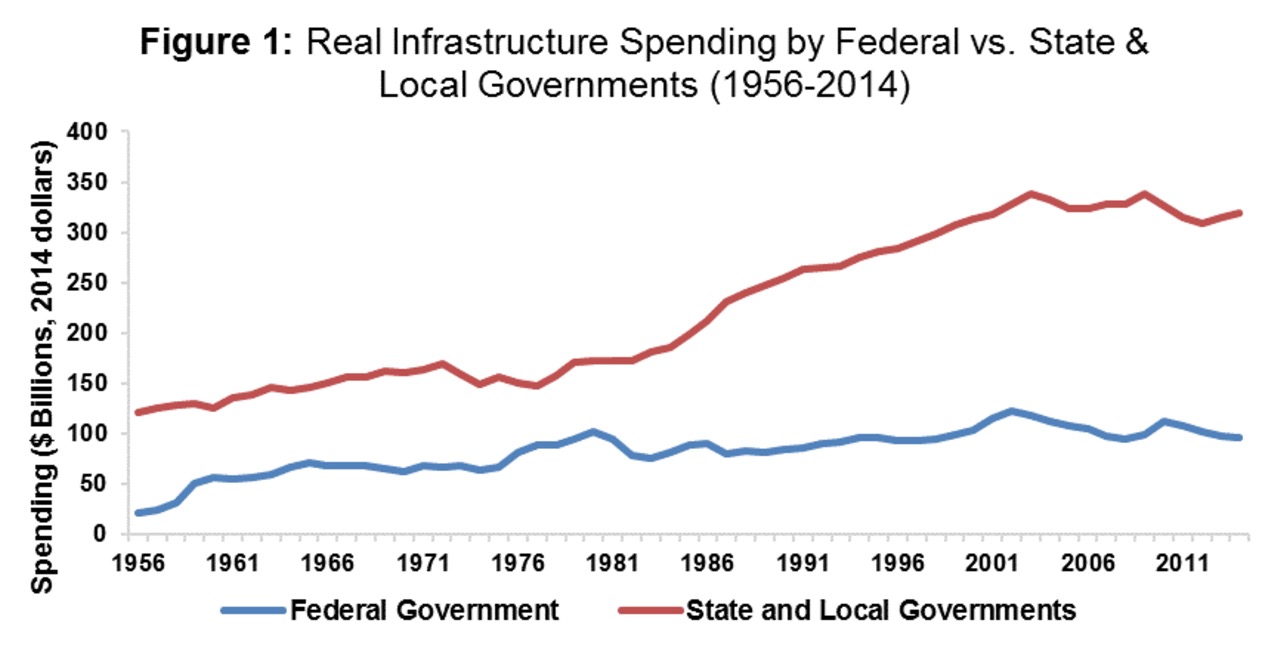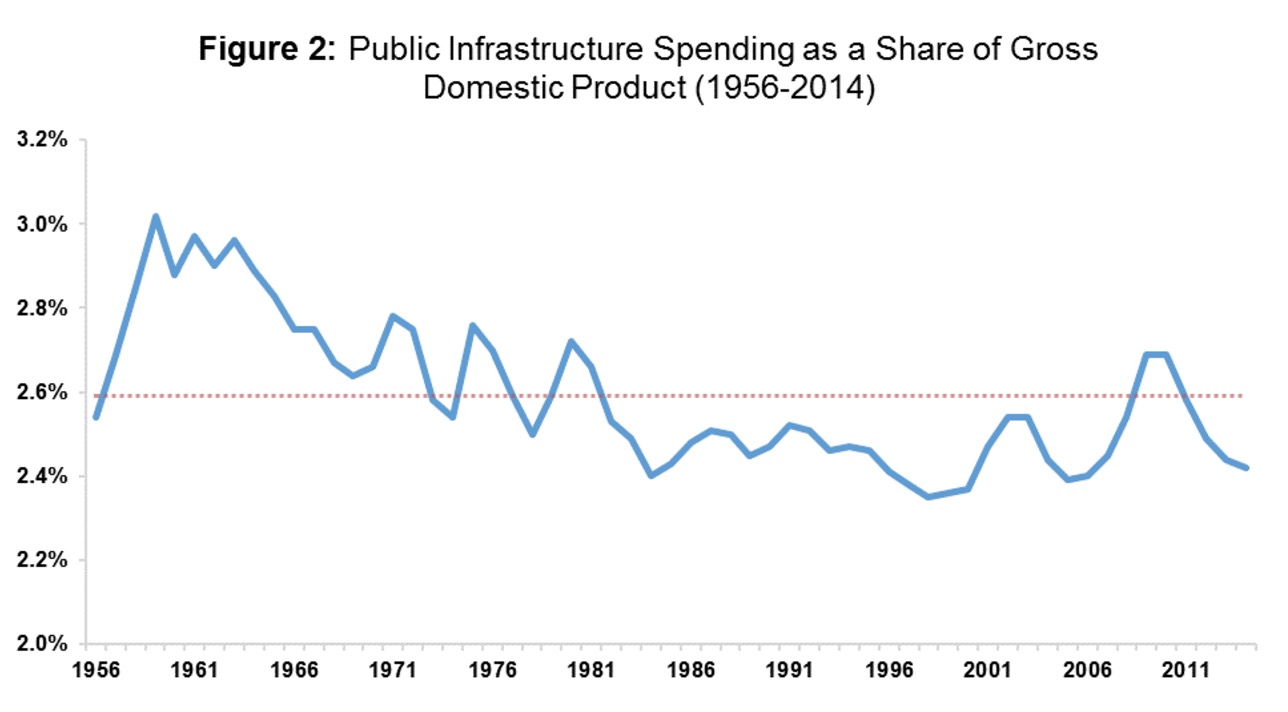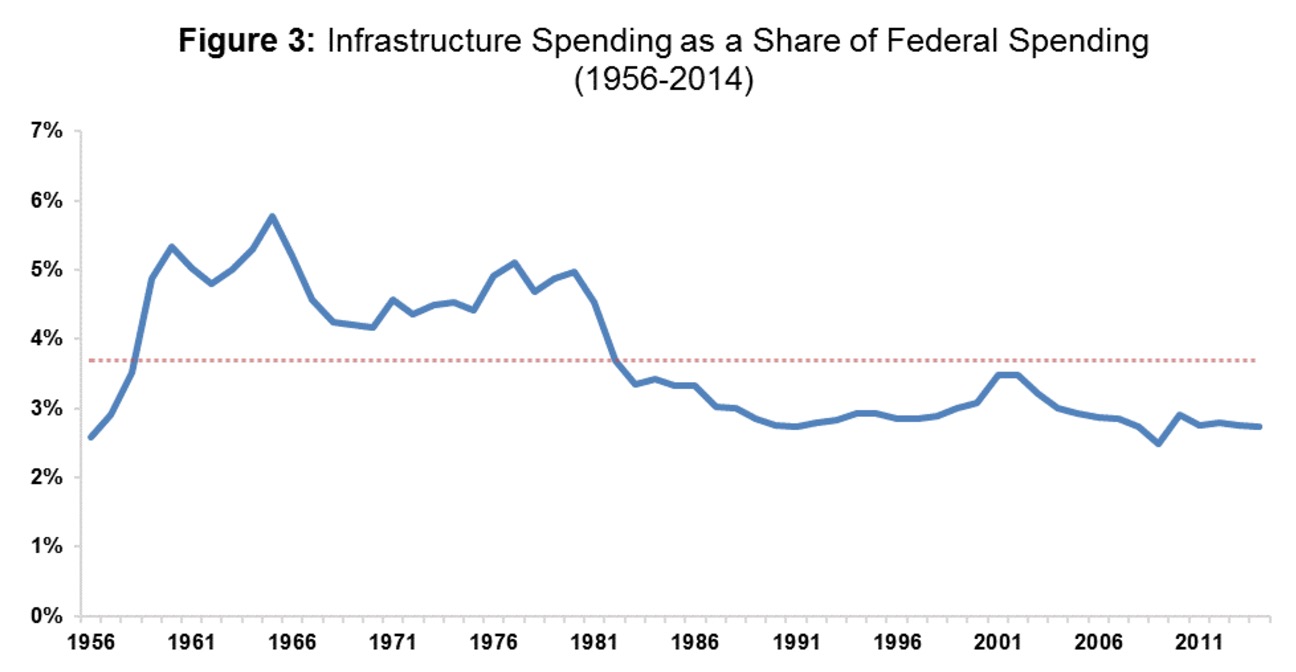AMERICAN ACTION FORUM
Written by Curtis Arndt
Summary
- The overall level of infrastructure spending by the public and private sector has increased since 1956.
- The U.S. would have to increase public infrastructure spending by $30 billion to get back to the 2.6 percent average share of GDP for the period between 1956 and 2014.
- The U.S. would have to increase federal infrastructure spending by $33.4 billion to get back to the 3.7 percent average share of federal spending for the same period.
- Real fixed capital per worker has increased 50 percent between 1956 and 2015.
- As of 2014, the U.S. spends more on infrastructure operation and maintenance than new capital by $54.5 billion, or 30 percent.
- The decline in U.S. infrastructure can’t be explained by a decrease in spending. The likely explanations are that the infrastructure needs have changed or the quality of infrastructure spending has weakened.
Introduction
American infrastructure has recently come under heavy criticism. The American Society of Civil Engineers gave the state of U.S. infrastructure a D+ grade in 2013 and estimates $3.6 trillion in investment is needed by 2020 to alleviate infrastructure shortcomings. Both presidential candidates proposed infrastructure spending to address this investment gap. Hillary Clinton proposed spending $275 billion over a 5-year period to address infrastructure needs, including $25 billion to create an infrastructure bank. President-elect Donald Trump proposed spending $1 trillion on public infrastructure. (AAF released research evaluating the presidential candidates’ proposal with emphasis on the need for an efficient funding strategy.)
This paper confronts perceived infrastructure failings with the data on public and private real infrastructure spending over recent decades. Interestingly, the data do not immediately point to a specific explanation for the poor perceived state of infrastructure. Accordingly, we turn to some possibilities that might explain the gap, such as changes in infrastructure needs and the quality of infrastructure spending.
Public Sector Infrastructure Spending Trends
Figure 1 uses CBO data[1] from 1956 to 2014 to display the level of real (inflation-adjusted) public spending for transportation and water infrastructure. The data reveal that total infrastructure spending has been on the rise over the past six decades. Although state and local government spending grew more substantially, the federal government also increased its real level of spending.
Figures 2 and 3 use CBO data[2] and present the transportation and water infrastructure spending as a share of GDP and federal spending, respectively.
For the years between 1956 and 2014 in Figure 2, infrastructure spending as a share of GDP does not deviate greatly from its average of 2.6 percent. Note, however, that the 2014 infrastructure spending share is below the average, that the spending share has fallen behind since 2011, and that in the absence of the American Recovery and Reinvestment Act (ARRA, or “stimulus”) the share has been below average for 35 years. The 2014 infrastructure spending share was 2.4 percent and would need an additional $30 billion to get back to the 2.6 percent average. This $30 billion gap from the average would be easily covered by either presidential candidates’ proposal.
Figure 3 shows the share of infrastructure spending in overall federal outlays, and tells a story similar to that in Figure 2. That is, infrastructure spending has slipped in importance as a priority of the federal government. The 2014 infrastructure share of federal spending was 1 percentage point lower than the 3.7 percent average. To jump from 2.7 to the 3.7 percent average, infrastructure spending would have to increase by $33.4 billion dollars. This number is in line with the previous figure’s estimate and both candidates’ proposals would be sufficient to cover this shortfall.
View and download full version (americanactionforum.org): Infrastructure Spending Trends
About the American Action Forum (AAF)
https://www.americanactionforum.org/
AAF provides data-driven insight to today’s defining domestic policy challenges, utilizes both in-house policy experts and a broad network of outside experts, and deploys modern communications approaches to express ideas and effectively engage policymakers, thought leaders, academics, media, and the general public.
Tags: AAF, American Action Forum, Curtis Arndt









 RSS Feed
RSS Feed